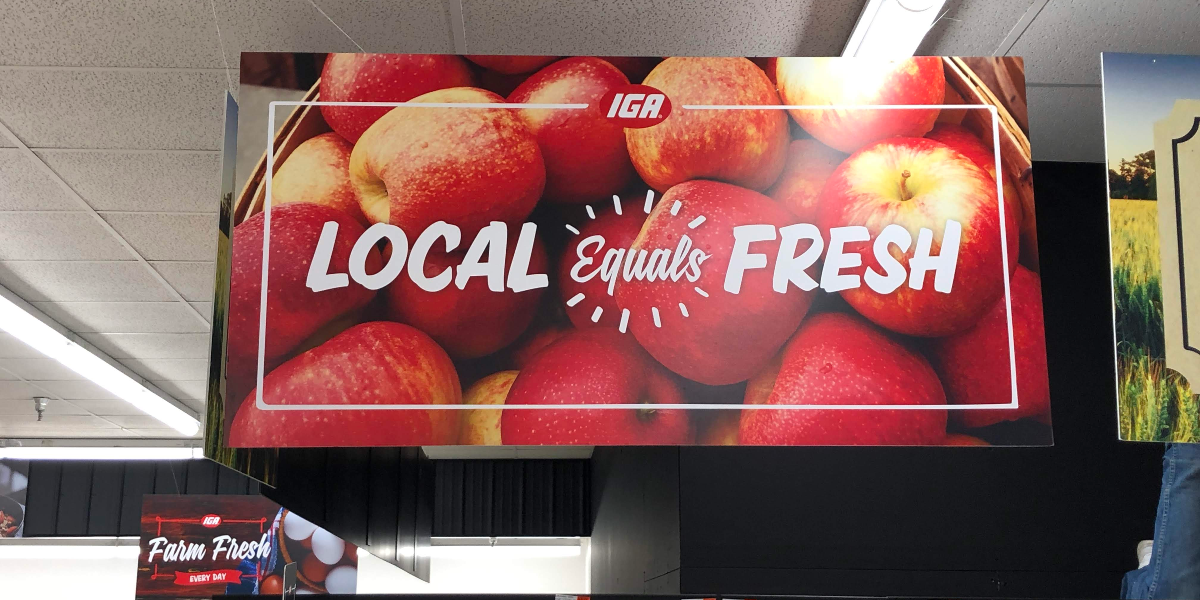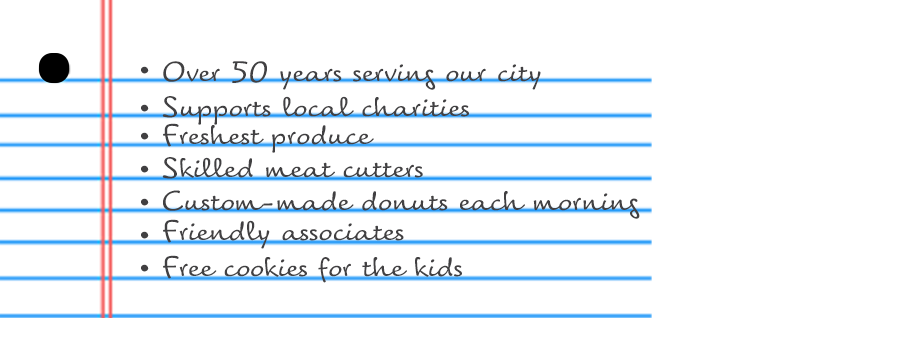Help Isom IGA recover from devasting floods

Close your eyes and think of name brands. What comes to mind first? Coke? Kleenex? Ray Ban? Apple?
Ever wonder how those companies created brands that are so recognizable, so powerful, that they seem to represent their industries?
It’s easy to imagine that they got there because they were pioneers in the industry, or that their products are just so good that they became superstar leaders before any competitors could catch them. Both would be true for almost every mega-brand.
But what is also true is that they worked on their brand. That’s right, building a brand wasn’t just something that happened—they applied tools and techniques and worked on improving their brands just like every other task in their company. All CEOs have a list of things they need to accomplish each year. Their lists include things like reducing costs, or opening a new location, or entering a new market. But leading company CEOs' lists of things to do is almost always a sentence like, “Grow and improve the brand.” And their board of directors, if they are smart, hold them accountable for it.
So how do you “work” a brand to ensure it is healthy, growing, and winning?
This is the first of three articles to help you answer that question, and to show how to build a strategy for improving your brands. And in turn, how to grow your top line revenue, and bottom line, too. For here is the hidden secret in branding: the leading brand grows market share faster, and makes more money than follower brands.
Part One: Positioning
The first step in growing your brand is deciding what your brand stands for. The marketing biz calls this positioning. Said simply, brand positioning is owning an attribute—more than anyone else—that identifies your brand in the consumer’s mind.
To do this you must first understand what you stand for in the shoppers’ mind today, which isn’t necessarily what you sell or what you do. A common mistake is confusing the business you are in with your brand: IGA sells groceries, but what we really do is feed our communities. Our brand is almost always bigger than what business we are in.
Step 1: Identify Your Strengths
Take a sheet of paper and write at the top, “Shoppers choose my brand over the competition because of these things." Now list all the things that make your store a better choice.
Your list might read like this:

You get the point. That is the list of things you do that help you stand out. Standing out is important in branding, though the word the marketing folks use is “differentiating.” What makes you different enough from the competitors that people will choose you over them?
The problem with this first step is that your list might not be your customers' list. Just because you do something different doesn’t mean it matters to your shoppers.
I worked on a regional bank's marketing many years ago, doing an exercise like this. They had a similar list of what they did to stand out: give back to the community, friendly tellers, fresh coffee in the morning, etc.
But when I brought in the shoppers for a focus group and asked, “What would make you shop Bank X over Bank Y?” a totally different list emerged. And the shoppers were really passionate about what they liked—and what they hated.
Turns out in banking, what consumers despised was the short bankers’ hours. They hated rushing to the bank for something after work only to get there and find the doors shut. They hated having to take time off their job, feeling held hostage by their local bank's unwillingness to work a minute more than they had to.
So, guess what? The bank changed their policies: later hours, open on weekends, etc. And the real genius of what they did is that they stayed open 30 minutes later than what they posted on the door, so any consumer who got there a tiny bit late could still have a great experience.
I wouldn’t tell this story if it didn’t work. They grew, bought out some other regional banks, made more money, and eventually got bought out.
So, in branding, we have to know that what we do actually matters. Those of you who read this blog, or see me speak at industry events, have seen me put up a slide of the top reason shoppers would choose one grocer over another. Price, selection, service, and convenience are still the top scores. But right there with them is freshness and quality.
Today’s grocery shoppers are more concerned about the quality of their food than ever before. And the younger they are, the more likely they are to seek fresh, healthy options. That’s why we up-branded the chain using the phrase “Local Equals Fresh.”
When we brought consumers into groups to discuss this new branding, they instantly loved it. First, it was something they were concerned about: “Big chains might buy from factories or ship food from too far away."
Second, it was something they believed only local stores could do: “My local grocer probably buys from local farmers. Farm-to-store-to-table is probably truer for them than a big national chain.”
If you haven’t looked at the branding materials we have now for the IGA brand, please do. The new visual merchandising is very powerful, shoppers love it, and they are moving to our brand more and more.
That’s what we did at the corporate level, but you’ve got your own brand, which also needs this same kind of work.
Step 2: Know What Matters to Shoppers
What’s your version of stay open later than other unfriendly banks?
It’s easy to do: ask your community. Give them a free donut or coffee for five minutes of their time. Ask them what you could do to ensure they (and their family) eat more meals from the products you sell than your competition. Or if you want to do more formal research, schedule a focus group or do an online survey. (Reach out to Dr. Paulo Goelzer in the IGA Coca-Cola Institute for help using more formal tools.)
Few brands can win on every attribute, but you need to be able to win on at least a few. This is the biggest part of brand positioning: choosing where to fight and how to win.
Step 3: Choose Where to Fight and How to Win
Let’s take a department like bakery. Maybe you have a hard time hiring a real baker in your market. Maybe you need to upgrade equipment but don’t have the capital right now. Knowing fresh bakery is important to your shoppers, you might decide that you will get to the bakery next year, and focus on other areas of the store. That’s totally fine.
But if you decided that bakery was going to be one of the areas where you differentiate and win, what could you do?
There are IGAs that have formed partnerships with local bakeries, inviting them to relocate in their store and share revenues. There are stores that hired bakers away from restaurants, offering them more manageable hours and friendly working environments to transform their bakeries. And we have IGAs who don’t bake anything at all, but give the illusion of fresh bakery with great merchandising.
This last point seems strange, right. How could you differentiate in a department like bakery if you don’t actually have a scratch bakery?
Look at Publix as an example. Like many of our stores, they only bake bread and a few cookies, always from prepackaged dough. They decorate cakes but don’t make them on site. Yet shoppers think Publix has great bakers. How?
First, great merchandising. They have big stickers on their baked goods, and clean, well-organized displays. Second, their cake decorators are excellent and friendly. And finally, they are constantly putting fresh-baked French bread out all over the store. They found that the baskets of fresh-baked French bread, at the front end, in deli, in the back aisle let shoppers assume that everything in their bakery was fresh baked. Clever, huh?
Other brands like Trader Joe's do a masterful job of this sort of marketing. Great packaging, great displays, friendly staff, nothing fresh, yet their shoppers love their offerings. Subway does the same trick. There is nothing fresh about cold cuts in metal trays, yet the smell of that fresh bread has shoppers giving them great marks in freshness.
Step 4: Build Your Plan to Win
My point is, don’t give up on an attribute too soon. Ask yourself, what could I do to differentiate? How could I win here, how could I help shoppers remember me for this?
Whether it’s bakery, meat, produce, customer service, cleanliness, or freshness, you have to actively choose where to fight and where to stand out. You want everyone in your community to hear your brand name and always think of one or two attributes. It’s like the car brand game where I say, "Volvo," and you say "safety;" I say, "BMW," you say, "performance," etc.
Building a plan to win is where many small businesses fail. They don’t actually put their plan on paper, they don’t actually think out what they need to do to win.
When I was with Home Depot, we decided to win in paint. We gathered our manufacturers, our partners, our associates, and said, "What do we need to do to win market share in paint? Lower prices? More brands? More choices? Better guarantees?"
At the time we were marketing paint based on quality. We had a big push on guarantees (15-year, 30-year, etc.). The merchants thought this was important to shoppers.
Turns out they couldn't care less. Most didn’t expect to be in the same home for 30 years. What they wanted were things like one-coat coverage, washability, and most importantly, they wanted help picking out the right colors.
We had to reset our focus and choose new attributes like color choice and ease of use to win; we had to give our brands the right challenge (Behr’s paint and primer in the same can is an example) and tighten our marketing on what matters to the shopper. It paid off. Home Depot exploded in the paint department and hasn’t looked back since.
I did an exercise with some retailers at one of our IGA Coca-Cola Institute leadership training sessions last year, where we picked an area in the store where we wanted to differentiate—in this case, produce—and we brainstormed tactics we need to take so everyone in your market believes we are the best choice for produce. Our minds first went to the basics: add more space to displays, offer more deals, etc. But those are tactics anyone can do. What could we do that was different? The team came up with some really cool ideas:
- Farmer of origin signs, so shoppers could learn where the product was grown and what made that farm so special.
- Social media and text blasts when new trucks came in. “Text 12345 to find out when the next truck of fresh strawberries from Anderson farms hits the store!”
- Branding your produce associates as “freshperts,” and using social media to let them give shoppers tips on how to choose a fresh melon or how to cook with squash, etc.
- Live web cam on local farmer fields, with a countdown to harvest (potato cam anyone?).
- Publishing a freshness policy or a guarantee. You would gladly take back a product your shoppers didn’t think was great, but do they know it? Do people who’ve never shopped your store know you guarantee freshness?
You get the idea.
Building a plan to differentiate is not hard. And solutions are well within the range of any independent. And what makes these kinds of assignments so cool is that you can involve your associates in the process and get them to help you win.
The next article in this series of three is called, “De-positioning: using competitors’ weaknesses to help drive sales.” The one that follows that is called, “Repositioning: how to address brand weaknesses.” Taken together it is a mini course in branding designed to help you plan, execute, and win.
I look forward to hearing how you use these tools to grow sales!
You May Also Like
These Stories on From the Desk of
Jan 7, 2026 3:20:24 PM |
5 min read
Dec 18, 2025 9:32:36 AM |
3 min read
Dec 10, 2025 4:57:50 PM |
1 min read


No Comments Yet
Let us know what you think